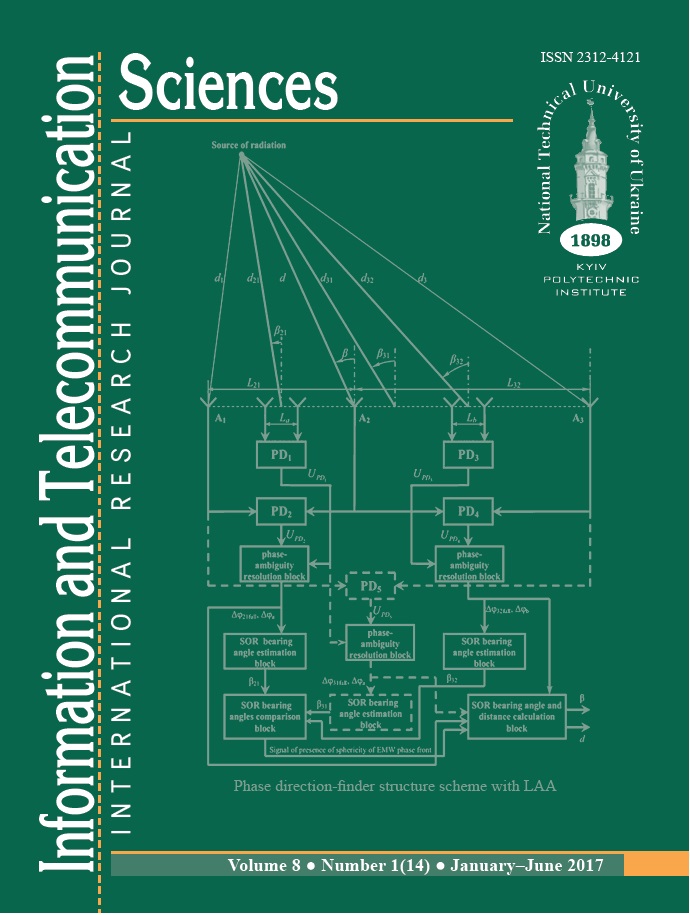AN APPROACH TO RESOURCE ALLOCATION FOR FUTURE WLAN
DOI:
https://doi.org/10.20535/2411-2976.12017.11-16Keywords:
5G, WLAN, DIDO, IoT, QoS, QoE (Quality of Experience)Abstract
Background. Nowadays wireless and mobile communication is occupied with provision in general of IP-services and transmission of MM-content from one place to another, but tomorrow the new 5G will be able to control a wide range of objects in real time with only insignificant human intervention. IoT with multiple new attractive apps is created. An important new approach for resource allocation for future WLAN towards 5G has to be discussed within the work.
Objective. DIDO (Distributed Input Distributed Output) – a new technology aimed to provide flexible multiuser wireless LAN everywhere under international voting and conventions for the used frequencies amongst other mobile technologies towards 5G. DIDO is aimed to resource allocation for future wireless communication networks which can use the wide non-traditional frequencies spectra between 3MHz and 30GHz and independently with full bandwidth and higher data rate operate under the distances between 100 m and 1000 km.
Methods. Analysis of all known publications devoted to the new generation of mobile communication 5G was done. The interoperability aspects of 5G to WLAN, BT, WSN and other micro- and pico- radio nets were discussed. A new approach to frequency resource allocation for future WLAN was examined.
Results. An overview is given as well as main research points of view for the future 5G of mobile radio networks by the IMT 2020 standard are examined. They include inter alia the technique DIDO (Distributed Input Distributed Output), a perspective resource allocation for future wireless communication networks. The technology should only augment the existing GERAN, UTRAN, SAE and IMS mobile radio infrastructure of previous generations 2G-4G with a flexible world-wide WLAN, which is operated under use of a data bases for available frequency bands and the Web-based content called DIDO Data Centers.
Conclusions. Efficient WLANs as well as DIDO must become a part of 5G systems. By the opinion of some leading companies like Rearden, Microsoft, Samsung, Huawei the method DIDO has to be used as a new resource allocation method for future WLANs.
References
5G-Laboratory@TUDresden (Online): http://5glab.de/
Frank Fitzek. 5G Next Generation Mobile Communication. In Proceedings of International Symposium on Microwave and Optical Technology (ISMOT), Dresden, June 2015.
Howard Benn. 5G Mobile Communications for 2020 and Beyond:
Vision and Key Enabling Technologies, Samsung, Oct. 2014.
5G Nanocore (Online, in German): http://de.scribd.com/doc/87616878/5G-the-Nano-Core
NanoZEIT@TUD (Online, in German): http://www.et.tudresden.
de/etit/index.php?id=556
A.Luntovskyy, D.Guetter, I. Melnyk. Planung und Optimierung von
Rechnernetzen: Methoden, Modelle, Tools für Entwurf, Diagnose und
Management im Lebenszyklus von drahtgebundenen und drahtlosen
Rechnernetzen. Springer/Vieweg + Teubner Verlag Wiesbaden, 2011,
p. ( in German).
A.Luntovskyy et al. Distributed Services for Telco Networks: Ubiquitous Computing and Cloud Technologies, Monograph, Lvivska Politechnika, Lviv, 2012, 368 p. (ISBN 978-966-2405-87-3, in Ukrainian).
A.Luntovskyy et al. Multiservice Mobile Platforms, Monograph, DUT State Univ. of Telco, Kyiv, 2014. – 216 p. (ISBN 978-977-2105-89-3, in
Ukrainian).
A.Luntovskyy et al. Data Security in Distributed Systems, Monograph,
Lvivska Politechnika, Lviv, 2014. – 464 p. (ISBN 978-966-322-397-1, in Ukrainian).
A.Luntovskyy et al. New Architectures in Distr. Systems, Monograph,
Kolo, Lviv-Drogobych, 2015. – 328 p. (ISBN: 978–617–642–185–6, in
Ukrainian).
T. Thieme. Challenges of the Internet of Things for sensor applications, wireless communication and new solutions of energy supply. In Proceedings of International Symposium on Microwave and Optical
Technology (ISMOT-2015), Dresden, June 2015.
Jennic Wireless Microcontrollers (Online): http://www.jennic.com/
J.Brien. WLAN for everybody: MS plans a world-wide WiFi-Net for the
Office clients, June 2015 (in German).
S. Hong et al. FQAM: A modulation scheme for beyond 4G cellular
wireless communication, Samsung Electronics, in Globecom Workshops, 2013 IEEE.
Steve Perlman et al. Distributed-Input-Distributed-Output Wireless
Technology: A New Approach to Multiuser Wireless, Whitepaper, Rearden.com, 2014, 19p.
Steve Perlman, Antonio Forenza. Introduction to pCell - Wireless Reinvented, Artemis Networks LLC, Whitepaper, 2015, 99 p.

